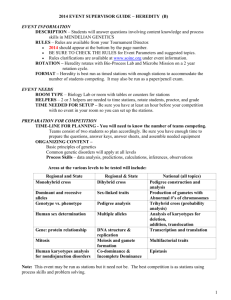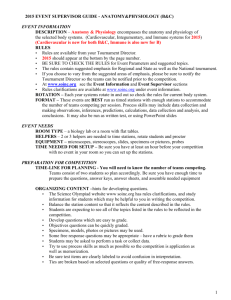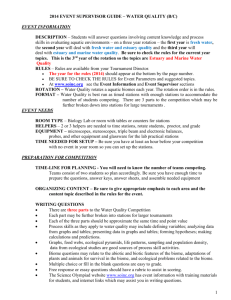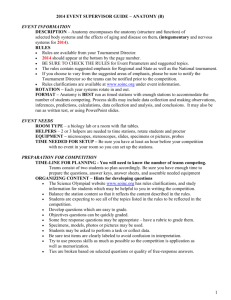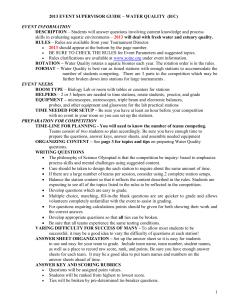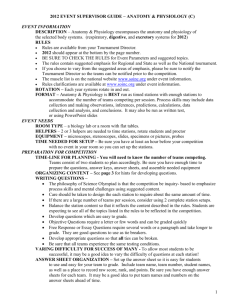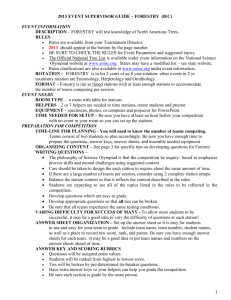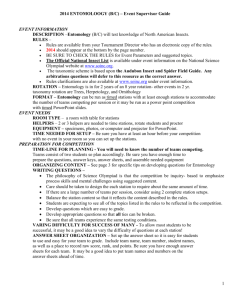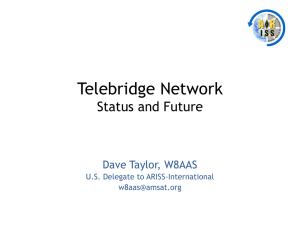ECOLOGY (B & C) - Science Olympiad
advertisement
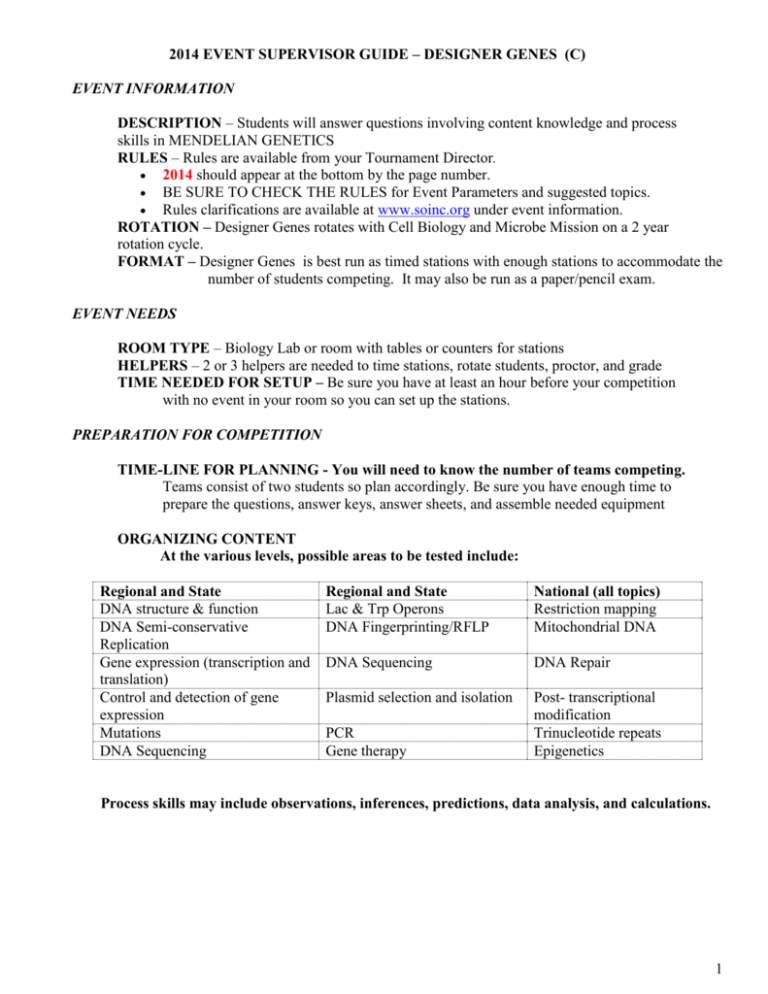
2014 EVENT SUPERVISOR GUIDE – DESIGNER GENES (C) EVENT INFORMATION DESCRIPTION – Students will answer questions involving content knowledge and process skills in MENDELIAN GENETICS RULES – Rules are available from your Tournament Director. 2014 should appear at the bottom by the page number. BE SURE TO CHECK THE RULES for Event Parameters and suggested topics. Rules clarifications are available at www.soinc.org under event information. ROTATION – Designer Genes rotates with Cell Biology and Microbe Mission on a 2 year rotation cycle. FORMAT – Designer Genes is best run as timed stations with enough stations to accommodate the number of students competing. It may also be run as a paper/pencil exam. EVENT NEEDS ROOM TYPE – Biology Lab or room with tables or counters for stations HELPERS – 2 or 3 helpers are needed to time stations, rotate students, proctor, and grade TIME NEEDED FOR SETUP – Be sure you have at least an hour before your competition with no event in your room so you can set up the stations. PREPARATION FOR COMPETITION TIME-LINE FOR PLANNING - You will need to know the number of teams competing. Teams consist of two students so plan accordingly. Be sure you have enough time to prepare the questions, answer keys, answer sheets, and assemble needed equipment ORGANIZING CONTENT At the various levels, possible areas to be tested include: Regional and State DNA structure & function DNA Semi-conservative Replication Gene expression (transcription and translation) Control and detection of gene expression Mutations DNA Sequencing Regional and State Lac & Trp Operons DNA Fingerprinting/RFLP National (all topics) Restriction mapping Mitochondrial DNA DNA Sequencing DNA Repair Plasmid selection and isolation Post- transcriptional modification Trinucleotide repeats Epigenetics PCR Gene therapy Process skills may include observations, inferences, predictions, data analysis, and calculations. 1 2014 EVENT SUPERVISOR GUIDE – DESIGNER GENES (C) WRITING QUESTIONS The philosophy of Science Olympiad is that the competition be inquiry- based to emphasize process skills and mental challenges using suggested content. Care should be taken to design the each station to require about the same amount of time. If there are a large number of teams per session, consider using 2 complete station setups. Balance the station content so that it reflects the content described in the rules. Students are expecting to see all of the topics listed in the rules to be reflected in the competition. Develop questions which are easy to grade. Multiple choice, matching, fill-in-the blank questions are quicker to grade and allows volunteers completely unfamiliar with the event to assist in grading. For questions requiring calculations points should be given for both showing their work and the correct answer. Develop appropriate questions so that all ties can be broken. Be sure that all teams experience the same testing conditions. VARING DIFFICULTY FOR SUCCESS OF MANY - To allow most students to be successful, it may be a good idea to vary the difficulty of questions at each station! ANSWER SHEET ORGANIZATION – Set up the answer sheet so it is easy for students to use and easy for your team to grade. Include team name, team number, student names, as well as a place to record raw score, rank, and points. Be sure you have enough answer sheets for each team. It may be a good idea to put team names and numbers on the answer sheets ahead of time. ANSWER KEY AND SCORING RUBRICS Questions will be assigned point values. Students will be ranked from highest to lowest score. Ties will be broken by pre-determined tie-breaker questions. Have extra answer keys so your helpers can help you grade the competition. Be sure each section is grade by the same person. RUNNING THE EVENT SET UP TIPS Items needed: test questions, items for each station, answer sheets, answer key, stop watches, extra pencils, tape It may help to have questions laminated or put in sheet protectors. This procedure eliminates damage or tampering during competition. Be certain that equipment and questions are placed at the station for easy access of the students. Taping questions to the table helps to keep stations organized and undisturbed. Using arrow may help students move from station to station. Bring extra items needed at stations as rulers. If one is needed, put three there. A quick supervisor checklist of useful items to include: answer keys, answer sheets, calculator , extra mm rulers, extra pencils extra set of questions, highlighter, masking tape, red pens, scotch tape stapler, stop watches or timers. 2 2014 EVENT SUPERVISOR GUIDE – DESIGNER GENES (C) CHECK IN TIPS - if possible allow all teams to compete even if one or both members are late. They may need to miss some stations but they can do part of the competition. Check each team member for wrist bands or approved ID before giving teams their answer sheet. Have extra pencils and direct students print their names on sheet. Direct student to turn off all non-permitted electronic devices. You may wish to have devices put in a designated spot, given to someone outside the room, or placed in the student back packs and stored at a designated spot in the room. Allow each team to have only what is permitted in the Event Parameters. Keep students away from the stations until you are ready to begin the competition. Give all directions and safety information to all teams before beginning. Explain the station setup scheme and rotation pattern to the students. ROTATION OF STUDENTS FOR STATIONS – Using arrows taped to the table helps students. Proctors can also be stations around the room to help with rotation. TIMING – Stop watches or timers are best for timing the stations. Have a person responsible for timing the event. PROCTORING – Use two or three helpers to help with rotation, checking equipment at stations, and proctoring the competition. You may want proctors to check microscopes, balances, and probes as the students rotate. If you train them during the first session, you can grade papers during successive sessions. DEALING WITH PROBLEM SITUATIONS – Have the cell phone numbers of officials DISQUALIFICATIONS OF A TEAM SHOULD BE RESTRICTED TO SAFETY ISSUES, CHEATING, OR ABUSIVE AND UNSPORTSMAN-LIKE BEHAVIOR. Be sure that tournament officials and coaches are notified of any disciplinary action. CHECK OUT TIPS Be sure to get an answer sheet from each team before you allow them to leave the competition. Be sure the team number, team names and member names are present and legible. Remind students to take all their backpacks and other possessions as cell phones. SCORING THE EVENT – DO NOT GIVE OUT RESULTS ANY TEAM OR COACH. CONSISTANCY IN GRADING – Have the same person grade the same section for all teams. CHECKING MATH AND RANKING – Be sure to check the math and ranking for all teams they are accurate. Scoring worksheets or computer programs may be available to help with ranking. so BREAKING TIES – Break all ties and indicate on the student answer sheets and score sheet how the tie was broken. The DECIMAL METHOD is a good way to indicate the winner of ties. Example: If two teams have the raw score tie of 83 for, the winner of the tie receives an 83.1 while the other teams gets 83.0. If several ties are broken, you have .1 to .9 to use. This also points out scores where ties were broken. 3 2014 EVENT SUPERVISOR GUIDE – DESIGNER GENES (C) SCORE SHEET – Fill in all information on the score sheet. Indicate how the raw scores are ranked – high score, low score or some other method. Be sure to include raw score, rank and points for each team. Explain how ties are broken. SCORE COUNSELING Have your score sheet completed and signed before going to score counseling Arrange student score sheets in rank order for quick checking. Turn in answer sheets, a copy of the test and an answer key to the Score Counselor. I hope these suggestions are helpful in organizing your tournament. Comments or new ideas are always welcome. Please send them to me at the following address. Karen L. Lancour 312 W. Bosley Alpena, Michigan 49707 karenlancour@charter.net 4
